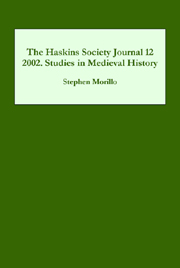Book contents
- Frontmatter
- Contents
- Editorial Note
- Abbreviations
- 1 Religious Houses and the Laity in Eleventh- to Thirteenth-Century England: An Overview
- 2 Two Yorkshire Historians Compared: Roger of Howden and William of Newburgh
- 3 The Rise and Fall of the Anglo-Saxon Law of the Highway
- 4 Consilium et Auxilium and the Lament for Æschere: A Lordship Formula in Beowulf
- 5 Royal Succession and the Growth of Political Stability in Ninth-Century Wessex
- 6 From Anglorum basileus to Norman Saint: The Transformation of Edward the Confessor
- 7 St þorlákr of Iceland: The Emergence of a Cult
- 8 Reshaping the Past on the Early Norman Frontier: The Vita Vigoris
- 9 The Appeal to Original Status in the Angevin Region (Eleventh–Twelfth Centuries)
- 10 Dudo of St. Quentin as an Historian of Military Organization
6 - From Anglorum basileus to Norman Saint: The Transformation of Edward the Confessor
Published online by Cambridge University Press: 12 September 2012
- Frontmatter
- Contents
- Editorial Note
- Abbreviations
- 1 Religious Houses and the Laity in Eleventh- to Thirteenth-Century England: An Overview
- 2 Two Yorkshire Historians Compared: Roger of Howden and William of Newburgh
- 3 The Rise and Fall of the Anglo-Saxon Law of the Highway
- 4 Consilium et Auxilium and the Lament for Æschere: A Lordship Formula in Beowulf
- 5 Royal Succession and the Growth of Political Stability in Ninth-Century Wessex
- 6 From Anglorum basileus to Norman Saint: The Transformation of Edward the Confessor
- 7 St þorlákr of Iceland: The Emergence of a Cult
- 8 Reshaping the Past on the Early Norman Frontier: The Vita Vigoris
- 9 The Appeal to Original Status in the Angevin Region (Eleventh–Twelfth Centuries)
- 10 Dudo of St. Quentin as an Historian of Military Organization
Summary
We are familiar with the image of Edward the Confessor as presented in the Bayeux Tapestry: old, frail and fading fast (figure 1). Familiar too is the later version of Edward, such as that seen in the fourteenth-century Wilton Diptych – still old, but now imbued with sanctity. But what of other conceptions of Edward? In the following pages I explore the transformation of the visual and textual expression of Edward's rule (1043–66) through the reign of Henry II (1154–89). I argue that during his lifetime Edward appropriated foreign iconography and ideology in order to equate his rule with that of his imperial counterparts in Germany and Byzantium. The subsequent Norman development of the cult of Edward altered traditions associating him with foreign courts, particularly Byzantium. New legends were introduced and existing ones revised to better reflect the current ideal of pious rulership and to buttress claims of Anglo-Norman royal legitimacy.
The only surviving depiction of Edward before his 1043 investiture is found in an illuminated encomium commissioned by and celebrating Emma, Edward's mother (BM Add. MS 33241, fol. 1v). The frontispiece depicts Emma seated on an architectural throne wearing jeweled robes and a large crown made more prominent by foliate projections (figure 2). The author of the encomium kneels before her, presenting his text for her approval. Behind him, peeking out from the architectural frame is Harthacnut, and squeezed behind him is Edward.
- Type
- Chapter
- Information
- The Haskins Society Journal 122002 - Studies in Medieval History, pp. 99 - 120Publisher: Boydell & BrewerPrint publication year: 2003

